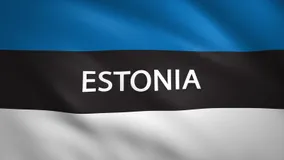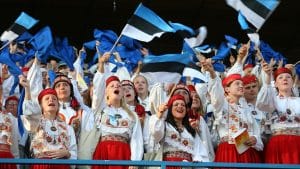Headlines
Estonia: A Small Country with a Big History

Estonia is a small country in northeastern Europe, bordering the Baltic Sea, Latvia, and Russia. It has a rich and diverse history, influenced by various cultures and powers that have ruled over it for centuries. Estonia is also known for its distinctive language, culture, and traditions, as well as its achievements in technology, education, and democracy.
See Population, Official Language And More…

Estonia
The earliest inhabitants of Estonia were the Finno-Ugric peoples, who arrived in the region around 8500 BC, after the end of the last Ice Age. They lived as hunter-gatherers, fishing, hunting, and collecting wild plants. They also developed a complex system of clans, headed by elders, and practiced animistic beliefs. The Estonians are first mentioned by the Roman historian Tacitus in the 1st century AD, who called them Aesti.
The first invaders of Estonia were the Vikings, who raided the coastal settlements and traded with the locals from the 9th century onwards. They were followed by the Danes and the Swedes, who attempted to Christianize the Estonians in the 11th and 12th centuries but met with fierce resistance. The Estonians fought back with their own leaders, such as Lembitu, who united several tribes against the foreign invaders.
In the 13th century, a new threat emerged from the south: the German crusaders, who came to conquer and colonize the Baltic lands in the name of Christianity. They were led by Albert of Buxhoevden, the bishop of Livonia, who founded the city of Riga and established the Order of the Sword Brothers, later merged with the Teutonic Order. The Germans waged a long and brutal war against the Estonians, who were eventually subdued and forced to accept feudalism and Catholicism.
The German rule lasted for more than 600 years, during which Estonia was divided into several provinces and estates, owned by nobles and church officials. The Estonians were reduced to serfs, who had to work on the land and pay taxes to their masters. They had no political or legal rights, and their culture and language were suppressed. The only exceptions were the towns of Tallinn and Narva, which enjoyed some autonomy and trade privileges as members of the Hanseatic League.
The German domination was challenged by several other powers that sought to control Estonia: Denmark, Sweden, Poland-Lithuania, and Russia. In 1561, Estonia became part of Sweden, which introduced some reforms such as education, administration, and law. The Swedish period is considered as a “golden age” for Estonia, as it saw the rise of a native intelligentsia and cultural revival. However, Sweden also imposed heavy taxes and conscription on Estonia, which led to several peasant uprisings.
In 1710, Estonia was conquered by Russia during the Great Northern War. The Russian rule was harsh and oppressive for Estonia, as it imposed serfdom, Orthodox Christianity, and Russification policies. The Estonians suffered from poverty, famine, disease, and exploitation. They also faced discrimination and persecution from the Russian authorities and settlers. The only positive aspect of the Russian period was the abolition of serfdom in 1816-1819, which gave some freedom and mobility to the peasants.
The 19th century saw the emergence of a national awakening movement in Estonia, inspired by the ideas of Romanticism and nationalism. The Estonians began to rediscover their history, language, literature, and folklore. They also formed cultural societies, schools, newspapers, and political organizations. They demanded more autonomy and rights from Russia, and expressed their aspirations for independence.
In 1918, after the collapse of the Russian Empire due to the Bolshevik Revolution and World War I, Estonia declared its independence and established a democratic republic. It was recognized by most countries in 1920, after it fought off attempts by Soviet Russia and Germany to annex it. The first period of independence was short-lived but significant for Estonia, as it developed its economy, culture, and education. It also faced some challenges, such as land reform, minority issues, and political instability.
In 1939, Estonia was forced to sign a pact with Nazi Germany and Soviet Union, which allowed them to establish military bases on its territory. In 1940, Estonia was occupied by Soviet troops and annexed into the USSR. The Soviet regime imposed a brutal dictatorship on Estonia, which involved mass deportations, executions, collectivization, censorship, and repression. Thousands of Estonians fled or resisted the Soviet occupation, joining the Forest Brothers guerrilla movement or forming exile communities abroad.
In 1941-1944, Estonia was occupied by Nazi Germany, which exploited its resources and persecuted its Jewish and Roma population. The Nazis also recruited some Estonians into their army, while others fought for the Soviet side or remained neutral. The war devastated Estonia, killing about a quarter of its population and destroying much of its infrastructure.
In 1944, Estonia was reoccupied by the Soviet Union, which resumed its oppressive policies and intensified its Russification efforts. The Estonians continued to resist the Soviet regime, both in the underground and in the international arena. They also preserved their national identity and culture, through music, art, literature, and religion.
In 1987-1991, Estonia participated in the Singing Revolution, a peaceful mass movement that demanded more autonomy and democracy from the Soviet Union. The Estonians used songs, rallies, human chains, and strikes to express their discontent and solidarity. They also restored their national symbols, institutions, and laws. In 1991, Estonia regained its independence, after a failed coup in Moscow and a referendum on sovereignty.
Since then, Estonia has been a successful and stable democracy, joining the European Union, NATO, and the eurozone. It has also developed a modern and innovative economy, based on information technology, e-government, and renewable energy. It has maintained good relations with its neighbors and allies, and promoted regional cooperation and security. Estonia has also preserved and celebrated its unique culture, language, and traditions, while embracing diversity and openness.





